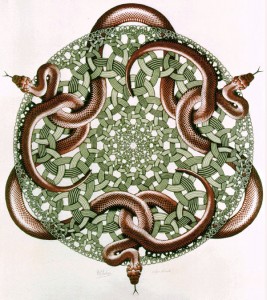 We come to Escher’s last print. It is a mandala. Bruno Ernst in his book The Magic Mirror of M. C. Escher observes, “In 1969, when Escher was already aware that he would once again have to undergo a serious operation, he used every possible moment in which he felt sufficiently fit to work on his last print: Snakes.”
We come to Escher’s last print. It is a mandala. Bruno Ernst in his book The Magic Mirror of M. C. Escher observes, “In 1969, when Escher was already aware that he would once again have to undergo a serious operation, he used every possible moment in which he felt sufficiently fit to work on his last print: Snakes.”
This print is again, an approach to expressing the infinite. It is composed of two elements: circles, and snakes.
At the outer radius of the print we have the suggestion of an infinite number of small circles. As we move radially inward, these smaller circles combine until we come to a dozen large circles. As we continue to move inward to the center of the print, the circles subdivide, almost like cells, into the suggestion of an infinite number of small circles at center of the print.
So what is Escher, a man at the end of his productive life, trying to tell us with his last print? Here is my speculation: The print depicts the full arc of evolution as proposed by Pierre Teilhard de Chardin. Out of an infinite number of possibilities at the periphery of the mandala mankind rises up. The 12 large circles indicate the arrival of mankind as the intellectual and spiritual pinnacle of the evolutionary process. (Interestingly, twelve is the number of tribes of Israel and the number of Apostles. It is often used to symbolize the whole Christian church.) Mankind continues to evolve into the infinite, the ‘Omega Point’. The convergence at the ‘Omega Point’ takes place at the center of the mandala.
This aspect of the image is satisfying because the mandala morphs from the infinite to the finite and back to the infinite again. It is composed entirely of circles. Whether Escher intended it, or not, the circle is the Christian symbol for God. If he intended this symbolism it would suggest that the hand of God present throughout the entire process of evolution. From beginning to end, which is consistent with the teachings of Teilhard.
What about the snakes? The print is named Snakes. Escher doesn’t use the snake or serpent motif in his work very often. However, early in his career, Escher rendered two interpretations of The Fall of Man(Men). In both 1920 and 1927 he created prints depicting the Genesis account of mankind’s original sin. With sin came death.
Note also that the circles are green in color. Green is the color for growth and life. The Snakes are rendered in brown. Brown is the color of spiritual death.
My speculation is that Escher contemplates his own death in this print. That would be his acknowledgement that death is woven into Teilhard’s evolutionary arc.
In The Phenomenon of Man Teilhard writes: “But on the other hand surely it [death] inevitably seeps out through every nook and cranny, through every joint and sinew of the system in which I have taken my stand.” And again: “Statistically, at every degree of evolution, we find evil always and everywhere, forming and reforming implacably in us and around us.”
I believe this is what Escher is depicting in his print Snakes as he considers his own death.
Interesting we find a man at the end of his life, driven to create one last work of art and he creates a mandala composed of the Christian symbols for God and Satan.
Escher was a very unique man. In him we have a man who contemplated Scripture. A man whose reflection on Scripture manifested itself in his life’s work. Escher used his gifts to bear Christian fruit.
(Note on art. Throughout this blog I am using Escher’s artwork unless otherwise noted. Escher’s art is still under copyright. I am claiming fair use. My rationale is that I am only using low resolution copies of Escher’s art. The images are readily available on the internet. The images are being used for educational purposes. My intent is to avoid detracting from the value of Escher’s original prints.)
